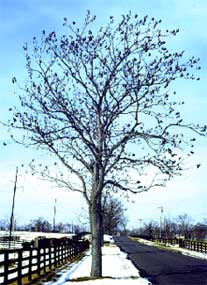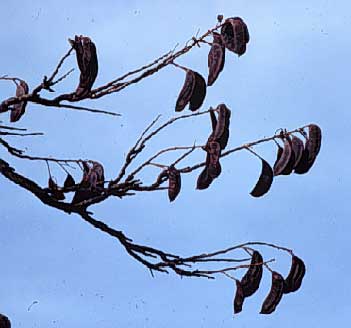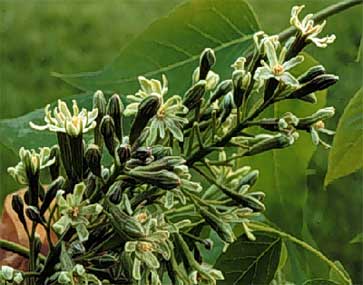Can You Grow Coffee Trees and Hops in Kentucky
At one time the Kentucky coffeetree was the designated state tree. It occurs throughout Kentucky, but is well-nigh common in open woods in the Bluegrass. The common proper name comes from the seeds existence used past pioneers equally a coffee substitute. The Kentucky champion tree is in W Liberty in Morgan County and is 90 feet tall. It is 1 of the largest Kentucky coffeetrees in the United states.
Introduction : Kentucky coffeetree is a unique tree with large, woody pods and very large leaves fabricated upward of smaller leaflets. Its common proper noun refers to the use of the pods by early settlers as a java substitute. With its bold class, contorted branching, unique bark and decorative clusters of big pods rattling in the air current, Kentucky coffeetree is an infrequent winter ornamental. Leaves emerge in tardily spring a hit pink-bronze color. Every bit the cute, large airy leaves mature they become nighttime bluish-green above. The calorie-free, airy shade (semi-shade) of this tree makes gardening under it possible. This tree's yellow fall color contrasts nicely with the clusters of dark, maturing pods.

Culture : This urban-tolerant tree is adaptable to a wide range of soils and climates, and will survive in dry out, compacted or alkaline soil. The Kentucky coffeetree prefers full sun and moist, rich soils. It should be pruned in wintertime or early on spring. Kentucky coffeetree has no serious illness or insect problems. Litter can be a problem in jump when pods autumn, and in autumn when the large leaves drop. Considering of litter, Kentucky coffeetree is best suited for large areas such as parks.
 Botanical Information
Botanical Information
- Native habitat: Northeastern and cardinal U.S. Growth habit - This tree has an irregular form with coarse branches.
- Growth addiction:
- Tree size: The coffeetree tends to accomplish a superlative of threescore to 75 feet with a 40- to 50-foot spread at maturity. It tin can reach a height of xc anxiety. Growth rate is slow to moderate.
- Blossom and fruit: Greenish-white, 1-inch flowers are arranged in panicles at branch tips. Panicles are 8 to 12 inches long on female trees; iii to four inches long on male trees. The poisonous fruit is a five- to 10-inch-long, brown, woody pod that contains gluey pulp and a few large seeds. The toxic alkaloid, cystisine, is neutralized in the roasting process.
-
 Leaf: Very big (3 feet long and two feet wide) compound leaves with numerous leaflets. They are pink-bronze when they emerge in the spring then dark bluish-green in summer. Fall colour is yellow but tends to be ineffective.
Leaf: Very big (3 feet long and two feet wide) compound leaves with numerous leaflets. They are pink-bronze when they emerge in the spring then dark bluish-green in summer. Fall colour is yellow but tends to be ineffective. - Hardiness: Winter hardy to USDA Zone 3b.
 Selected cultivars:
Selected cultivars:
There are several cultivars of Kentucky coffeetree that are bachelor in the plant nursery trade. They include selections that are predominantly male and practise not produce fruit. These are preferred as street trees because the large pods tin can make a mess in early spring when they are shed from the trees in large numbers. Male person selections include 'Espresso.'
The Kentucky coffeetree belongs to the pea or legume family. Although many members of the legume family unit have an association with a bacterium that converts gaseous nitrogen into a usable form, the Kentucky coffeetree cannot "set up" nitrogen.
Although widely distributed, this tree is a rare forest tree and occurs in scattered populations. The national champion Kentucky coffeetree, 97 feet tall, is in Maryland.
The fruit of Kentucky coffeetree is a typical legume pod,but the flowers are not the typical pea-like form nigh people acquaintance with legumes. There is some evidence to point that the Kentucky coffeetree was introduced into Kentucky by Native Americans, who used lurid from its wood to treat insanity. A tea made from leaves and pulp was used as a laxative. The seeds of Kentucky coffeetree were used by early settlers every bit a substitute for coffee. All the same, circumspection must exist taken considering the seeds and pods are poisonous. They contain the alkaloid cystisine that can be dangerous. Cystisine is thought to be neutralized in the roasting process. Cattle take died afterward drinking from pools of h2o containing fallen seeds and leaves from Kentucky coffeetree.
Gymnocladus dioicus is the botanical name for the Kentucky coffeetree. Gymnos is the Greek word for "naked" and klados is Greek for "branch." This name refers to the large, coarse branches (without smaller twigs) that remain later on the rachis and petiole of the bipinnately compound leaves autumn. The species proper name, dioicus, refers to the tree's dioecious nature.
Because leaves of this tree are tardily to emerge and early to fall, the Kentucky coffeetree is without leaves, or naked, much of the year. Kentucky coffeetree has the largest leaves of our woodland trees. The bawl is rough and furrowed and the older branches terminate in a flower cluster, forcing new branches to form in a "zig-zag" design. Kentucky coffeetree has reasonably strong wood and will tolerate some ice without losing branches.
Print fact canvass
Source: https://www.uky.edu/hort/Kentucky-Coffeetree
0 Response to "Can You Grow Coffee Trees and Hops in Kentucky"
Post a Comment